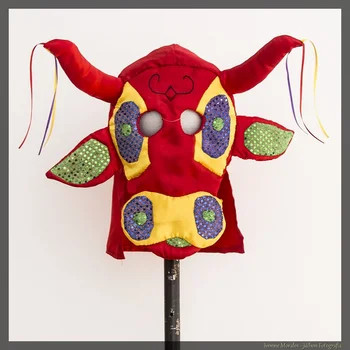The other faces of Colombia

Colombia is a country of hidden masks. It is far from the big cities, in small towns and villages, where little-known masks come to life in celebrations, rites, popular festivals and carnivals.
The diversity of masks in terms of their origin (Hispanic, indigenous and African), is the result of centuries of cultural syncretism, between Christian tradition, indigenous customs and the new reality of Africans brought as slaves to these lands.
The exhibition “The Other Faces of Colombia. Collection of Latin American masks Claudio Rama” is made possible thanks to the kindness and support of the Embassy of the Republic of Colombia in Uruguay and the MAPI – Museum of Pre-Columbian and Indigenous Art, of the Municipality of Montevideo.
Ten cultural manifestations with their most representative masks will be on display. Among them are those used in the festivities of the Riosucio Carnival, the Barranquilla Carnival, the rural patron saint festivities of the department of Boyacá, the Tikuna rituals of the Amazon jungle, the carnivals of Ibagué, the Cuadrillas of San Martín, the popular manifestations in the San Andrés Village in Girardota, in the city of Rio de Oro in César and in the Sibundoy Valley.
Some of these masquerade manifestations are very widespread, but most of them are little known outside their places of origin. In all of them we can appreciate the traces of the hybridity that has emerged from the social and cultural miscegenation between Europeans, Indians and Africans, which have marked the history of Colombia and all of our America. But we also find cultural manifestations that have remained almost unchanged, such as the Tikuna rituals in the Amazon jungle.
As part of another cultural world, these pieces made from tree bark show the intimate relationship with nature. Or the masks used by the Indians of the Sibundoy Valley in Alto Putumayo, an ancestral expression of the Inga and Kämentsá Indians and used in ancient yagé ceremonies.
The best known have been the masks of the Barranquilla Carnival (declared Cultural Heritage of Humanity by UNESCO). This popular festival, originated in the 19th century, brings together millions of people and multiple cultural and folkloric varieties of the Colombian Caribbean. This carnival uses costumes that invoke different animal species, people, mythological beings, with countless inventions and occurrences every year.
Most of the masks are carried-danced in the bacchanals on hot days of revelry that once had a more religious imprint. Among the most traditional masks is the Marimonda, made with a long nose and big ears to ridicule the ‘high society’. As in the rest of our Latin America, the Colombian masks of Diablos, inserted in a plot-dance between good and evil, as in the carnivals of Barranquilla or Riosucio, constitute testimonies of the European evangelization as well as elements of cultural resistance of the different peoples, groups and individuals oppressed since colonial times.
Another masquerade of European origin present in Colombia is the Danza de los Matachines. It takes place in many towns of mining Antioquia, in El Tolima de los Pijaos or in the city of Ibagué. The “Matachín”, was in its European genesis the masked buffoon or ridiculous person, but also a dance of coronation of the chieftain or of preparation of wars practiced by different native peoples.
Both manifestations remind us of the history of our continent, the contributions of different groups or societies, the syncretisms, the impositions, the resistances and the dangers, today more than ever, that threaten the greatest wealth of Latin America, its cultural diversity.
Like many of the pieces in my collection, these have been acquired over many years. During this mask fishing in Colombia, many people and institutions helped me. I am deeply grateful to them, especially to the Universidad Nacional Abierta y a Distancia (UNAD), and to many of its teams, thanks to which I have had long periods of work and many visits to different towns. Echo. Claudio Rama.

